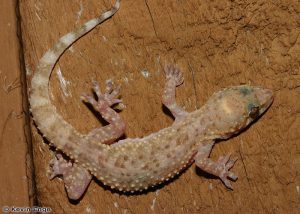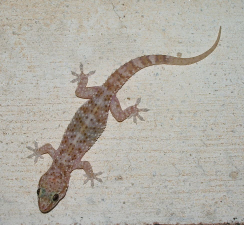I am not sure if this would be listed as an EDRR invasive species for our area. In my home anyway, they were once common and are now hard to find. This is the Mediterranean Gecko.
In the 10 southeast states, it has been reported in 7 of them. There are 1,418 records on www.EDDMapS.org. They are distributed all across the southern half of the United States and as far north as Washington D.C. It is from the Mediterranean part of the world and was first reported in Key West, Florida in 1915. One idea on how it has dispersed to so many locations is the eggs are often laid on vegetation or produce; this being harvested and shipped all over the world. It is also popular in the pet trade, which probably led to the spread of these lizards.

Photo: Kevin Enge (UF)
They are small lizards (4-5 inches) with big eyes and sticky toe pads. This gecko is almost translucent, with a pinkish color to them. They are nocturnal and most active on warm nights. They emerge from their daytime hiding places to hunt a variety of insects but are particularly fond of moths and cockroaches. They often sit on walls near outdoor lights the ambush their prey. I have found them inside my house in the pantry – no doubt seeking the prey I hope they find and eat! It seems kind of squeamish when you first see them, but they are totally harmless.
They lay several clutches of two eggs during the warm months of the summer. Male geckos are known for making sounds (unusual for any lizard) and it resembles a chirping bird. It is probably used as the dewlap is used with the Anole – to ward off rival males and attract females. Geckos are one type of lizard that lacks eyelids, rather they use their tongue to clean and wipe a clear protective coat over their eyes. If that is not impressive to you… try it! Try and lick your eye with your tongue! Not easy is it.
They seem to be highly associated with humans and not common in natural areas. They probably have several predators we do not know about. It has been reported that Cuban Treefrogs will eat them. As far as their “invasiveness” I would say… no. Let’s run down the invasive check list…
– Nonnative – yes, they are nonnative being from the Mediterranean part of the world.
– Brought here by humans – yes again, but probably accidentally at first, now intentionally with the pet trade.
– Causing environmental or economic harm – it does not appear to be. There is no evidence that this animal is causing any damage or harm where it exists.
Understanding that you need all three to be labeled “invasive” – I would lean towards no on this one. One report from Texas indicated that they are resistant to many insecticides used to try and control them. That is pretty interesting.

Photo: Texas State University
Like I said, they were at one time VERY common at our house, but I have not seen one in over a year. BUT I think I will go gecko hunting tonight – why don’t you!
ACTIVITY
– Search www.EDDMapS.org distribution points for the Mediterranean Gecko. Are there any local ones?
– Let’s see if we can find some.
Ø Daylight Hours – they like to hide in cracks in the wall, boards, under bricks and rocks. I have found them hiding in my garage.
Ø Nighttime Hours – turn the porch lights on at sunset and check every once in a while. One report indicated their peak activity time is around 2:00 AM. Do not stay up that late, but maybe check the front and back porch each hour until you go to bed.
HAVE FUN AND STAY SAFE
 0
0
